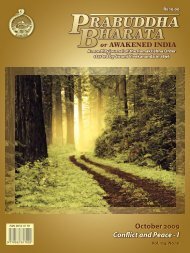P
PB Cover July 2011.indd - Advaita Ashrama
PB Cover July 2011.indd - Advaita Ashrama
- No tags were found...
Create successful ePaper yourself
Turn your PDF publications into a flip-book with our unique Google optimized e-Paper software.
Natha Pantha:<br />
Order of the Primordial Shiva<br />
Dr Satish K Kapoor<br />
While Pashupata Shaivas, Lakulishas,<br />
Kapalikas, and kalamukhas<br />
were progressively losing contact with<br />
people during the first half of the second millennium,<br />
Natha Pantha—presumably originated<br />
in north and north-east Bengal—spread<br />
across India.<br />
Natha Pantha is also known as Adinatha Sampradaya,<br />
‘Order of the Primordial Shiva’, Yogi<br />
Pantha, ‘Order of Yogis’—Kanaphata (spliteared)<br />
yogis or Siddha (realized) yogis—Goraksha<br />
Pantha, ‘Sect of Goraksha (or Gorakha)’, or<br />
Siddha Siddhanta Padyati, ‘Methods and Principles<br />
of Realized Ones’.<br />
Natha Pantha remained popular throughout<br />
the previous millennium and was influenced,<br />
to some extent, by the austere tantra doctrines<br />
of the Shaiva, Shakta, Sahajiya, Siddha Baul,<br />
and Bauddha traditions.1 Yet Nathas—natha<br />
means lord, master, or protector—distinguished<br />
themselves by their unitive metaphysics; high<br />
standard of morality; prohibition of madya and<br />
māmsa, liquor and animal food; mastery over<br />
asanas, yogic postures, and prāṇa, vital breath;<br />
extraordinary control over mind and body;<br />
herbal or alchemical knowledge; magical or<br />
mystical feats; powers of benefaction; and the<br />
ability to communicate with plants and animals<br />
as well as to predict future events. In course of<br />
time magicians, sorcerers, snake-charmers, wandering<br />
ascetics with wonder-drugs, and many<br />
more who worshipped Shiva or practised yoga<br />
came to its fold. But all of them did not wear<br />
PB July 2011<br />
big earrings—mudrā or karṇa-kunḍala—or<br />
aim at spiritual realization. The Nathas did not<br />
posit God outside the creation and believed that<br />
each human is perfect, though only a few could<br />
realize this fact.<br />
For Natha Panthis the supreme master of<br />
all is Shiva—also called Adinatha, from whom<br />
everything ensues, than whom nothing is<br />
greater, and without whom none can experience<br />
bliss. The Nathas were different from Kapalikas,<br />
Mattamayuras, and Aghoris as they did<br />
not indulge in gory practices like śava-sādhanā,<br />
spiritual practice on a corpse—mentioned in<br />
the Kaula vali Nirnaya (14.75–260), the Kulachudamani<br />
(6.19–28), and other tantric texts—<br />
or observe the pañcamakāra, practice of the five<br />
‘M’s, as opposed to vedācāra, Vedic rules of conduct.<br />
They disapproved of such obnoxious rites<br />
as mārana, killing, uccāṭana, disturbing others,<br />
haraṇa, carrying away, and stambhana, preventing<br />
others from doing something, commonly observed<br />
by left-handed sects. The Nathas affirmed<br />
that the human body is a miniature universe that<br />
must not be neglected or polluted by wicked<br />
thoughts or immoral actions. Hence, they advocated<br />
the strengthening of the body, like the<br />
thunderbolt of Indra, through the practice of<br />
kāya-sādhanā,2 involving control over breath,<br />
the senses, and the mind as well as the use of<br />
alchemical preparations, specially those related<br />
to mercury and sulphur—symbolically associated<br />
with Shiva and Shakti—as also herbal drugs<br />
like bilva (Aegle marmelos), haritaki (Terminalia<br />
489
















